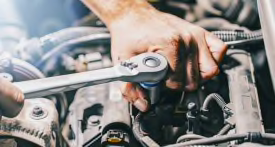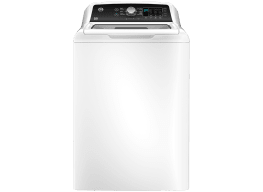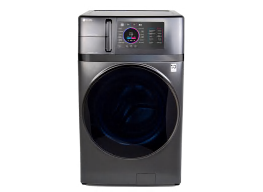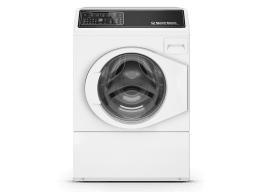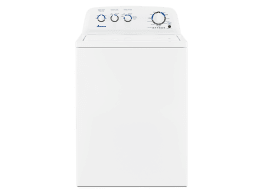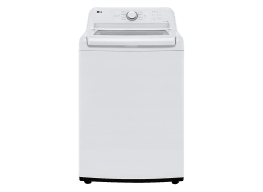Should You Repair or Replace Your Broken Washing Machine?
CR’s interactive tool leverages product costs, depreciation rates, and survey data to help you make the right choice. Plus, expert advice on what to do next.
When you shop through retailer links on our site, we may earn affiliate commissions. 100% of the fees we collect are used to support our nonprofit mission. Learn more.
When your washing machine breaks, how do you know whether to roll up your sleeves, work the phones to find a repair technician, or give in and swipe your Visa at the nearest appliance dealer? It’s a decision that about 20 percent of CR members were confronted with, according to recent surveys in which we collected data on 75,242 new washers purchased between 2012 and 2022.
Repairing an almost new machine or replacing an ancient one are relatively easy decisions from a cost perspective. But what happens when your washer falls in the middle and is, say, 4 to 7 years old? Considering that a washer’s shelf life is close to 10 years, it can be hard to decide whether to invest in fixing a middle-aged washer or just cut bait and buy a new one.
We can help you decide. Enter the age and original cost of your washer below, along with the cost to repair it, if you have that information. The meter at the right will steer you toward your most cost-effective option based on estimated repair costs, the original purchase price, and the current value of your washer based on years of ownership.
Consider it a launchpad to guide you through that panicked moment when your washer quits and dirty clothes pile up. And then read on for more detailed information to help you decide: Should I fix it or nix it?
Factors to Consider
If you spent $650 on your washer seven years ago and you’re doing seven loads per week (a lot of wear and tear), a new washer purchase makes sense. But if the machine is 3 years old and you spent $1,000 on it, a repair may be the better financial choice.
Typical Washer Problems
Washing machine problems vary according to type. CR members cited odor problems with front-loaders and compacts, tangled clothes with top-loaders (HE and agitators), and clothes not cleaning thoroughly with top-load HEs. But surveys tell us consumers are more tolerant of mediocre washing performance issues. Breakdowns, which require repair, are a different matter.
Fortunately, broken washers are few and far between. According to our most recent member survey, only 14 percent of washers broke in the second through fifth year of ownership, a relatively low number. Here are common washing machine repair problems:
- The control panel doesn’t work.
- Water isn’t draining.
- The washer is vibrating excessively.
- There are water leaks.
- The drum doesn’t spin properly.
- The drain pump is clogged.
- There’s odor, mold, or mildew.
Your Manufacturer’s Warranty
Most washer warranties cover a year, though Speed Queen offers warranties of up to seven years on some models. Our survey suggests this isn’t a major factor for most shoppers, but whether or not your washer is covered will take on new importance the minute it stops working.
Here are some things you can do to determine if your problem is covered under warranty or if it’s worth turning to the manufacturer for a repair.
- Find out what your manufacturer’s warranty covers, including any stipulations that could deny you coverage. Read the fine print.
- Check the brand website and online forums to see if the problem is part of a recall or a recurring one that suggests the company may replace a part or the washer itself. With today’s smart washers, some brands can even offer certain fixes with a downloaded patch.
- Review the owner’s manual and online resources to determine whether the problem can be addressed with a simple fix like replacing a knob, cleaning a filter, or rebalancing the wash load inside the machine.
Research Before You Call a Repair Tech
YouTube is a popular resource to diagnose appliance problems or just to see if others are experiencing similar issues. You can also scour washer and repair reviews on Google and Yelp. But wading through a riptide of comments, hacks, and ragtag advice takes time and sound judgment, so be wary. Unless you have some experience in appliance repair, you’re probably better off with an expert fix from a more reliable source.
Product manuals and brand web pages can also help you troubleshoot your washer’s problem. Some appliances even have built-in self-diagnostic systems. If that fails, try calling the brand’s customer service hotline or using its web chat portal. But be aware that some brands simply issue automated responses online, and others will only send a technician. You know what that means: a costly house call.
Appliances and Electronics Should be Easy to Fix—Not Just Thrown Away!
If you turn to a pro, expect to drop some money upfront before receiving your repair quote. Unless you’re handy or have an appliance tech friend, there’s little way around this. Once you’ve doled out that service fee, it might be hard to say no to the quote unless it’s outrageously priced compared with the value of the washer itself.
“The service charge is going to be at least $100 to $150,” says Dean Landers, president of Landers Appliance, a certified washing machine service center in Baltimore. “Some may say no to a service charge, but they’ll cover their costs by increasing the labor. Others separate the two for transparency.”
Our most recent survey reveals that the median cost for out-of-pocket washer repair costs was $155. Median repair costs differ based on the machine type (not counting the service quote fee).
- Top-Load Agitator Washers: $129
- Top-Load HE Washers: $165
- Front-Load Washers: $171
Making Greener Choices
• Save More and Waste Less All Around the House.
• Repair vs. Replace: Refrigerators, Ranges, Dishwashers, Dryers.
• Choose products that last with our Appliance Brand Reliability Rankings.
• Make your life more eco-friendly with CR’s Guide to Sustainable Living.
If You Decide to Repair Your Washer
In our 2021 survey, 67 percent of CR members surveyed attempted to repair their washers when they broke. Two-thirds of these repairs were handled by repair professionals, but about 33 percent attempted to repair their washer themselves or through a friend or family member. CR doesn’t recommend that you fix a washing machine unless you’re quite handy and it’s a minor issue. Today’s machines are complex. If you’re replacing a button or clearing a filter, that’s one thing. Repairing a motor to manufacturer specifications is another. You may also find that you don’t have access to the specialized parts and tools typically reserved for authorized distributors.
“It really depends on the person’s skill level,” says Rich Handel, CR’s laundry expert. “If you need to replace the drum bearing for a front-load washer, it’s complicated. You basically need to take the whole thing apart to get to it.”
Whom Do You Call for Washer Repair?
Among those who relied on professional repairers:
- An independent repair shop completed 53 percent of CR members’ repairs.
- The retailer who sold them the washer did 25 percent of them.
- The manufacturer was selected for 22 percent of the professional repairs.
“We examined repair outcomes by the type of repair professional hired,” says David Gopoian, CR’s research program leader. “Consumers who reach out to independent repair shops are typically more satisfied with their repair results than those who have their repairs handled by retailers or manufacturers.”
According to that survey, 91 percent of repairs by professionals were successful, although 19 percent of those required a follow-up repair visit. More than half—56 percent—of washer repairs were at least partly covered by a manufacturer’s warranty or an extended warranty. Of washer repairs not covered by warranties, 80 percent were done by independent shops.
Although there’s insufficient survey data to nail down median repair costs for specific washer problems, the median cost for water drainage problems was $195. The median cost for faulty control panel problems was $173.
If you decide in the end that a repair isn’t worth it, you can opt to replace your washing machine.
Here’s a pulled-back look at the data that informs our tool above, worth considering as you shop.
Top-Rated Washing Machines
Here are top-rated models from our ratings, some of which are Green Choice eco-friendly washers from brands that offer top-notch reliability as well as water and energy efficiency.
